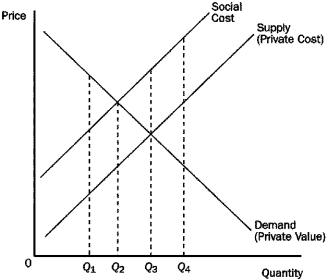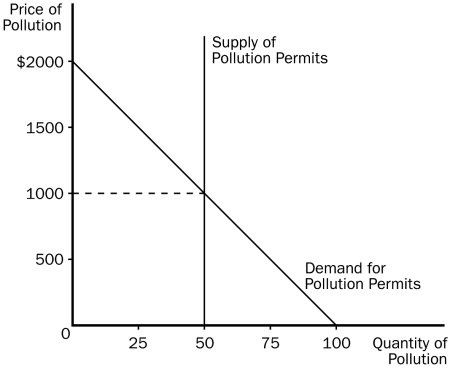A) private markets will under-supply college classes.
B) private markets will over-supply college classes.
C) the government should impose a tax on college students.
D) government intervention cannot improve the market for college classes.
Correct Answer

verified
Correct Answer
verified
Multiple Choice
Most economists prefer corrective taxes to regulation to correct the pollution problem because:
A) the market-based solution is less costly to society.
B) the market-based solution can result in a greater reduction in pollution.
C) the market-based solution raises revenue for the government.
D) all of the above.
Correct Answer

verified
Correct Answer
verified
True/False
Many charities like the Sierra Club are established to deal with externalities.
Correct Answer

verified
Correct Answer
verified
Multiple Choice
When an externality is present,the market equilibrium is
A) efficient,and the equilibrium maximizes the total benefit to society as a whole.
B) efficient,but the equilibrium does not maximize the total benefit to society as a whole.
C) inefficient,but the equilibrium maximizes the total benefit to society as a whole.
D) inefficient,and the equilibrium does not maximize the total benefit to society as a whole.
Correct Answer

verified
Correct Answer
verified
Multiple Choice
Suppose that meat producers create a negative externality.What is the relationship between the equilibrium quantity and the socially optimal quantity of meat to be produced?
A) They are equal.
B) The equilibrium quantity is greater than the socially optimal quantity.
C) The equilibrium quantity is less than the socially optimal quantity.
D) There is not enough information to answer the question.
Correct Answer

verified
Correct Answer
verified
Multiple Choice
Figure 10-4  -Refer to Figure 10-4.Without government intervention,the equilibrium quantity would be
-Refer to Figure 10-4.Without government intervention,the equilibrium quantity would be
A) Q1.
B) Q2.
C) Q3.
D) Q4.
Correct Answer

verified
Correct Answer
verified
Multiple Choice
One reason that private solutions to externalities do not always work is that
A) government intervention negates the benefits of positive externalities.
B) some people benefit from externalities.
C) interested parties incur costs in the bargaining process.
D) charities are not well organized.
Correct Answer

verified
Correct Answer
verified
Multiple Choice
All externalities
A) cause markets to fail to allocate resources efficiently.
B) cause equilibrium prices to be too high.
C) benefit producers at the expense of consumers.
D) cause equilibrium prices to be too low.
Correct Answer

verified
Correct Answer
verified
Multiple Choice
Table 10-1
The following table shows the private value,private cost,and external cost for various quantities of output in a market.
 -Refer to Table 10-1.How large would a corrective tax need to be to move this market from the equilibrium outcome to the socially-optimal outcome?
-Refer to Table 10-1.How large would a corrective tax need to be to move this market from the equilibrium outcome to the socially-optimal outcome?
A) 2
B) 3
C) 9
D) 10
Correct Answer

verified
Correct Answer
verified
Multiple Choice
Suppose that Company A's railroad cars pass through Farmer B's corn fields.The railroad causes an externality to the farmer because the railroad cars emit sparks that cause $1,500 in damage to the farmer's crops.There is a special soy-based grease that the railroad could purchase that would eliminate the damaging sparks.The grease costs $1,200.Suppose that the farmer has the right to compensation for any damage that his crops suffer.Assume that there are no transaction costs.Which of the following characterizes the efficient outcome?
A) The railroad will continue to operate but will pay the farmer $1,500 in damages.
B) The railroad will purchase the grease for $1,200 and pay the farmer nothing because no crop damage will occur.
C) The farmer will incur $1,500 in damages to his crops.
D) The farmer will pay the railroad $1,200 to purchase the grease so that no crop damage will occur.
Correct Answer

verified
Correct Answer
verified
Multiple Choice
Figure 10-11  -Refer to Figure 10-11.This graph shows the market for pollution when permits are issued to firms and traded in the marketplace.In the absence of a pollution permit system,the quantity of pollution would be
-Refer to Figure 10-11.This graph shows the market for pollution when permits are issued to firms and traded in the marketplace.In the absence of a pollution permit system,the quantity of pollution would be
A) 25
B) 50
C) 75
D) 100
Correct Answer

verified
Correct Answer
verified
Multiple Choice
Figure 10-4  -Refer to Figure 10-4.If this market is currently producing at Q2,then total economic well-being would increase if output
-Refer to Figure 10-4.If this market is currently producing at Q2,then total economic well-being would increase if output
A) increased beyond Q4.
B) decreased to Q1.
C) increased to Q3.
D) stayed at Q2.
Correct Answer

verified
Correct Answer
verified
True/False
In a market characterized by externalities,the market equilibrium fails to maximize the total benefit to society as a whole.
Correct Answer

verified
Correct Answer
verified
Multiple Choice
Internalizing a positive externality will cause the demand curve to
A) shift to the right.
B) shift to the left.
C) become more elastic.
D) remain unchanged.
Correct Answer

verified
Correct Answer
verified
Multiple Choice
If an externality is present in a market,economic efficiency may be enhanced by
A) increased competition.
B) weakening property rights.
C) better informed market participants.
D) government intervention.
Correct Answer

verified
Correct Answer
verified
Multiple Choice
Table 10-4
The following table shows the total costs for each of four firms (A,B,C,and D) to eliminate units of pollution from their production processes.For example,for Firm A to eliminate one unit of pollution,it would cost $46,and for Firm A to eliminate two units of pollution,it would cost a total of $103.
 -Refer to Table 10-4.If the government charged a fee of $93 per unit of pollution,how many units of pollution would the firms eliminate altogether?
-Refer to Table 10-4.If the government charged a fee of $93 per unit of pollution,how many units of pollution would the firms eliminate altogether?
A) 5
B) 6
C) 12
D) 16
Correct Answer

verified
Correct Answer
verified
True/False
Firms that can reduce pollution easily would be willing to sell their pollution permits.
Correct Answer

verified
Correct Answer
verified
Multiple Choice
Which of the following statements is correct?
A) Because a clean environment is a public good,a feasible goal is to eliminate all pollution,regardless of the cost.
B) Rich countries usually have cleaner environments than poor countries because a clean environment is like other normal goods in that it has a positive income elasticity.
C) Clean water and clean air are priceless goods.
D) All of the above are correct.
Correct Answer

verified
Correct Answer
verified
Multiple Choice
Markets are often inefficient when negative externalities are present because
A) private costs exceed social costs at the private market solution.
B) externalities cannot be corrected without government regulation.
C) social costs exceed private costs at the private market solution.
D) production externalities lead to consumption externalities.
Correct Answer

verified
Correct Answer
verified
Multiple Choice
When negative externalities are present in a market
A) private costs will be greater than social costs.
B) social costs will be greater than private costs.
C) only government regulation will solve the problem.
D) the market will not be able to reach any equilibrium.
Correct Answer

verified
Correct Answer
verified
Showing 241 - 260 of 352
Related Exams